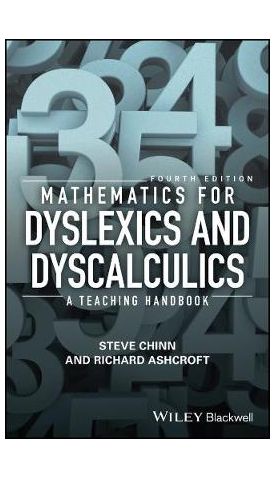אנו משתמשים ב-Cookies כדי לשפר את החוויה שלך. כדי לקיים ההנחיה החדשה של e-Privacy, עלינו לבקש את הסכמתך להגדיר את ה-Cookies. קבלת מידע נוסף.
242.00 ₪
Mathematics for Dyslexics and Dyscalculics - A Teaching Handbook 4e
242.00 ₪
ISBN13
9781119159964
יצא לאור ב
Hoboken
מהדורה
4th Edition
זמן אספקה
21 ימי עסקים
עמודים
360
פורמט
Paperback / softback
תאריך יציאה לאור
13 בינו׳ 2017
מחליף את פריט
14502692000
A seminal handbook in the field for more than 20 years, this new and updated edition of Mathematics for Dyslexicsand Dyscalculics contains the latest research and best practices for helping learners with numerical and mathematical difficulties.
A seminal handbook in the field for more than 20 years, this new and updated edition of Mathematics for Dyslexicsand Dyscalculics contains the latest research and best practices for helping learners with numerical and mathematical difficulties. * Provides a complete overview of theory and research in the fields of dyslexia and dyscalculia, along with detailed yet pragmatic methods to apply in the classroom * Contains enhanced coverage of place value and the role of the decimal point, why fractions can challenge a developed logic for arithmetic, and the complexity of time along with new material on addressing anxiety, fear, motivation, and resilience in the classroom; and links to new resources including standardized tests and recommended reading lists * Written by two mathematics teachers with 50 years of teaching experience between them, much of it in specialist settings for students with specific learning difficulties * Offers effective teaching strategies for learners of all ages in a structured but accessible format
| מהדורה | 4th Edition |
|---|---|
| עמודים | 360 |
| מחליף את פריט | 14502692000 |
| פורמט | Paperback / softback |
| ISBN10 | 1119159962 |
| יצא לאור ב | Hoboken |
| תאריך יציאה לאור | 13 בינו׳ 2017 |
| תוכן עניינים | Foreword xi 1 Dyscalculia, Dyslexia and Mathematics 1 Introduction 1 Definitions of Dyslexia 3 The Evolution of Definitions of (Developmental) Dyscalculia 5 The Nature of Mathematics and the Ways it is Taught 19 2 Factors that may Contribute to Learning Difficulties in Mathematics 23 Potential Areas of Difficulty in Learning Mathematics 24 General Principles of Intervention 44 Summary 46 3 Cognitive (Thinking) Style in Mathematics 48 Introduction 48 Qualitative and Quantitative Style 49 Cognitive (Thinking) Style in the Classroom 51 Examples 54 Summary 61 4 Testing and Diagnosis 62 A Diagnostic Test Protocol 64 Structure of the Diagnostic Protocol 65 Attitude and Anxiety 73 Thinking Style or Cognitive Style 74 Tests for Dyscalculia 74 Summary of the Test Protocol 74 5 Concept of Number 76 Introduction 76 Early Recognition of Numbers and Their Values 78 The Language of Mathematics (see also Chapter 2) 79 Early Number Work 79 Visual Sense of Number 82 Visual Clues to Number Concept 83 Number Bonds/Combinations 84 Place Value 86 Number Bonds/Combinations for Ten 93 Numbers Near Ten, Hundred or Thousand 94 Summary 95 6 Addition and Subtraction: Basic Facts/Number Combinations 96 Introduction 96 Strategies for Learning/Remembering the Addition and Subtraction Facts 99 Overview 107 Subtraction Facts 108 Extension 109 7 The Times Tables Facts/Number Combinations 110 Introduction 110 Rote Learning Strategies 110 Learning by Understanding 113 The Commutative Property 115 Learning the Table Square 117 Summary 135 8 Computational Procedures for Addition and Subtraction 136 Estimation 138 Addition 138 Teaching Subtraction as a Separate Exercise 147 9 Multiplication 152 Introduction 152 Multiplying by Ten and Powers of Ten 153 Multiplication 157 Estimation 163 Extension 163 10 Division: Whole Numbers 165 Introduction 165 Introduction to Division 166 Estimating 172 Division by Powers of Ten 173 Division by Multiples of Powers of Ten 174 Conclusion 174 11 Fractions, Decimals and Percentages: An Introduction 175 Introduction 175 Fractions 176 Decimals 187 Percentages 195 Overview 203 12 Operating with Fractions 204 Introduction 204 Making Segment Sizes the Same 205 Comparing Fractions 207 Combining Fractions 210 Adding Fractions 212 Subtracting Fractions 216 Combined Additions and Subtractions 219 Multiplying by Fractions 221 Multiplying Mixed Fractions 224 Dividing with Fractions 227 13 Decimals 232 Introduction 232 Addition and Subtraction 232 Multiplication and Division by Powers of Ten 235 Division of Decimals 242 Summary 249 14 Percentages 250 Introduction 250 An Image of Percentage 250 Summary 256 15 Time 257 What are the Potential Problems with Time? 258 Reading the Time 260 Time Problems 264 Summary 268 16 Teaching the Full Curriculum 269 Introduction 269 Some General Principles 270 Teaching the Other Parts of the Curriculum 277 Combining the Parts of the Curriculum 282 Summary 286 17 Attacking and Checking Questions 287 Practice Examples 287 Preliminary Checks 288 Attacking Questions 290 Methods of Attacking Questions 291 Checking 298 18 Important Elements of a Teaching Programme 303 Introduction 303 Consider the Pupils Needs 303 The Structure of the Course 304 Classroom Management: Making the Lessons Suit the Pupils 308 Evolving Expectations and Emphases 309 Internal Assessment 313 Summary 315 Appendices Appendix 1: Books, Journals, Tests and Games 316 Appendix 2: Teaching Materials 321 References 324 Index 337 |
| זמן אספקה | 21 ימי עסקים |



Login and Registration Form